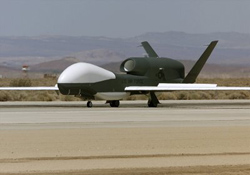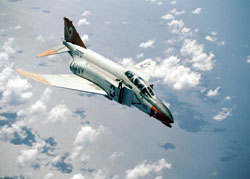Page 1
Daily News
By Gail Helmer
| Send Us News | Archives | Main |
Wednesday April 24, 2002
PC News
- IL-2 Servers Now Online
- Uncommon Valor: Campaign for the South Pacific Gold
- Seawolf Skipper Describes Navy's Newest Sub Class
- Crew Members Killed at Point Mugu Air Show
- Predators Akin To Traditional Aircraft -– Sort Of
IL-2 Servers Now Online
Ubi Soft has announced that the dedicated IL-2 servers are now online. Please remember that these servers are live but are in a test phase. For more information head over to the official IL-2 Sturmovik website.
Uncommon Valor: Campaign for the South Pacific Gold
Matrix Games has announced that Uncommon Valor: Campaign for the South Pacific has completed testing and gone gold. Co-developed with the legendary Gary Grigsby, Keith Brors and Joel Billings of 2 by 3 Games, Uncommon Valor is a completely new operational game covering the campaign in the area around Australia, New Guinea and Guadalcanal during World War II.
Uncommon Valor models the full scope of land, air and sea battles in the South Pacific from mid 1942 through the end of 1943. The beautifully rendered game map stretches from Truk in the north to Brisbane in the south. Ships, squadrons and regiments are detailed down to each gun, each pilot and each squad, respectively. While Uncommon Valor showcases a new level of historical accuracy, the interface is designed to minimize micro-management for casual gamers while allowing grognards to delve into the details. Uncommon Valor includes eighteen scenarios and campaigns, which can be played against the computer opponent, hot-seat against another human, or by a secure play by e-mail system. A scenario and unit editor is included to allow players to edit and create their own historical scenarios.
Military News
Sixth Global Hawk Successfully Completes First Flight
A Global Hawk unmanned aerial vehicle, the sixth to be produced for Northrop Grumman Corporation's high-altitude, long-endurance reconnaissance system, successfully completed its first flight Tuesday, April 23, 2002. The air vehicle took off from Northrop Grumman's final assembly facility in Palmdale, Calif., and landed four hours and 27 minutes later at the Birk Flight Test Center at Edwards Air Force Base, Calif. The UAV reached an altitude of approximately 61,000 feet during the flight.
Seawolf Skipper Describes Navy's Newest Sub Class
The skipper of the Navy's most advanced undersea war fighting platform, USS Seawolf (SSN 21), told an audience of submarine community supporters how his ship's inaugural deployment performance set a "solid demonstration for any class of submarine for years to come."
Cmdr. Butch Howard, the commanding officer of Seawolf, spoke at the spring luncheon meeting of the Naval Submarine League's Washington chapter April 17 at Fort Myer, Va. The 20-year Navy veteran and graduate of Auburn University led Seawolf on a six-month, 33,200-mile deployment concluding with its return in December to its homeport of New London, Conn.
Designed to be world's quietest submarine, Seawolf is reportedly less detectable at high speed than a Los Angeles-class submarine is while sitting at the pier. Advanced weaponry and new tactical capability and communications combined with an increased weapons load of Mark 48 anti-submarine torpedoes, Harpoon missiles and Tomahawk cruise missiles allow Seawolf to operate from under arctic ice to shallow water close to shore. A special addition, Howard noted, was the computer-driven, autopilot helm allowing the ship to cruise at a level depth in some cases better than the helmsman. "This thing is a Ferrari," he said.
Following a six-month period of what Howard described as depot-level repairs, Seawolf deployed in June with a relatively inexperienced crew; 11 of his 14 officers and 65 percent of the enlisted Sailors would deploy for the first time in their careers on what would prove to be a multi-theater and multi-mission assignment.
The terrorist attacks on Sept. 11 sent the submarine from its independent mission steaming in the Northern Atlantic within 48 hours to the Straits of Gibraltar and the Mediterranean to join the USS Theodore Roosevelt (CVN 71) battle group. Because of the circumstances of submarine operations, "we didn't' hear details of the attacks until days later, and we didn't' see the actual news coverage for weeks later," Howard said. Crew emotions, he added, "were all over the map, but at least we were in a good position to do something about the attacks."
During preparations for Operation Enduring Freedom, Seawolf played a role in the North Atlantic Treaty Organization (NATO) exercise Destined Glory 2001. The ship enjoyed a chance to test its stealth abilities against a Spanish submarine, closing to extremely close range before the ship "lit up sonar to let them know where we were."
Seawolf met up with the tender USS Emory S. Land (AS 39) to trade the submarine's torpedo payload for cruise missiles and set off to use its exceptional speed and stealth capability to support the war on terrorism.
Howard was proud of the fact that Seawolf sent out fewer casualty reports during its first deployment than "the average boat on the waterfront. Importantly, the skipper explained that the crew used commercial-off-the-shelf equipment, the core of the submarine force's modernization plan, and based on needs discovered during its deployment, will help determine maintenance needs for the other two Seawolf-class submarines to help the Navy stock repair parts.
Hosting the event is one way the Naval Submarine League promotes the importance of submarines to national security and serves as an independent authority on undersea warfare to the public and influential opinion-leaders. (Source: Submarine Warfare Division Public Affairs)
Crew Members Killed at Point Mugu Air Show
Cmdr. Michael Norman, a Navy pilot, and Marine Corps Capt. Andrew Muhs, a radar intercept officer, were both killed April 20 when their QF-4 Phantom II crashed while performing in the Point Mugu Air Show.
Both victims were members of the Naval Weapons Test Squadron Point Mugu. The aircraft crashed onto a country road bordering the Navy base while performing with three other squadron aircraft. No other injuries were reported.
The Navy is conducting an investigation into the cause of the crash.
Predators Akin To Traditional Aircraft -– Sort Of
he Predator is just like every other aircraft, you just do not ride in it. That is the conclusion of Lt. Col. Eric Mathewson, commander of the 15th Reconnaissance Squadron at Nellis Air Force Base, Nev. He should know, as his unit flies 24 of the unmanned aerial vehicles on missions worldwide.
Mathewson, who flew F-15 Eagles before joining the squadron, said pilots qualified in other aircraft feel right at home in the Predator world. The whole process involved in flying a mission in a Predator is virtually the same as any other aircraft, he said. Before each mission, pilots attend briefings covering weather, route and intelligence reports.
"You step to the airplane and do the pre-flight check," Mathewson said. "When you're finished, instead of getting in the cockpit, you get in a ground-control station."
The transportable station is like a cockpit. Predators are flown the same as crewed aircraft are. A pilot sits in the left seat, the officer in charge of the sensors is in the right seat and behind them is a flight engineer. The cockpit control array includes a stick, rudder and all the other switches, buttons and lights any other plane would have.
Once in, they start engines, taxi and it is "ready for takeoff." The same procedures apply upon landing. "We land, taxi back and debrief the mission just like any other," Mathewson said. Mathewson said there were some surprises when he came to the aircraft. "For one, it's larger than I thought," he said. "Also, when you are flying the aircraft, you know you're not aboard it, but you think you are."
Mathewson, who has commanded the squadron for 18 months, said pilots also realize they are not in simulators, but on real missions. There is no pushing the reset button if they are "shot down" or encounter an unrecoverable problem. "You are aware that what you're controlling is a real aircraft," he said. In fact, flying the Predator is harder than flying a manned aircraft in many ways, he said. "It's more challenging than landing an F-15," he said. "There's no sound, no 'seat-of-the-pants' feel to it, and the peripheral vision is limited."
Maintenance of the aircraft is the same as any other plane in the Air Force. Mathewson said the same number of specialties is needed to maintain the aircraft, generate and plan missions, and service the payloads. All told, Predator squadrons have 350 to 400 people, including 27 pilots assigned. He said aircrew members come from all walks of Air Force life. He has crew members who started in C-17 Globemaster IIIs, KC- 135 Stratotankers, F-15s and C-141 Starlifters.
Another thing the Predator can do that other aircraft cannot is switch crews. The aircraft can fly up to 40 hours at a stretch, but there is no need for one crew to fly the whole mission, Mathewson said.
"We mitigate the fatigue by changing out pilots and sensor operators every four hours," he said. "Pilots and sensor operators have so much information to process that four hours is about as much as they can take. Each mission is briefed to a crew of two pilots and four sensor operators."
The aircrews in the squadron have to adhere to the same crew rest routines and must meet the same physical requirements as manned-aircraft crew members. Mathewson said the experience with the Predator has been eye-opening for him.
"I'm a zealot," he said. "I know this is going to be part of the air power future, and I can see from our successes in Operation Enduring Freedom that this is going to play a pivotal role in air power for years to come." (Source: American Forces Press Service)
| Send Us News | Archives | Main |



